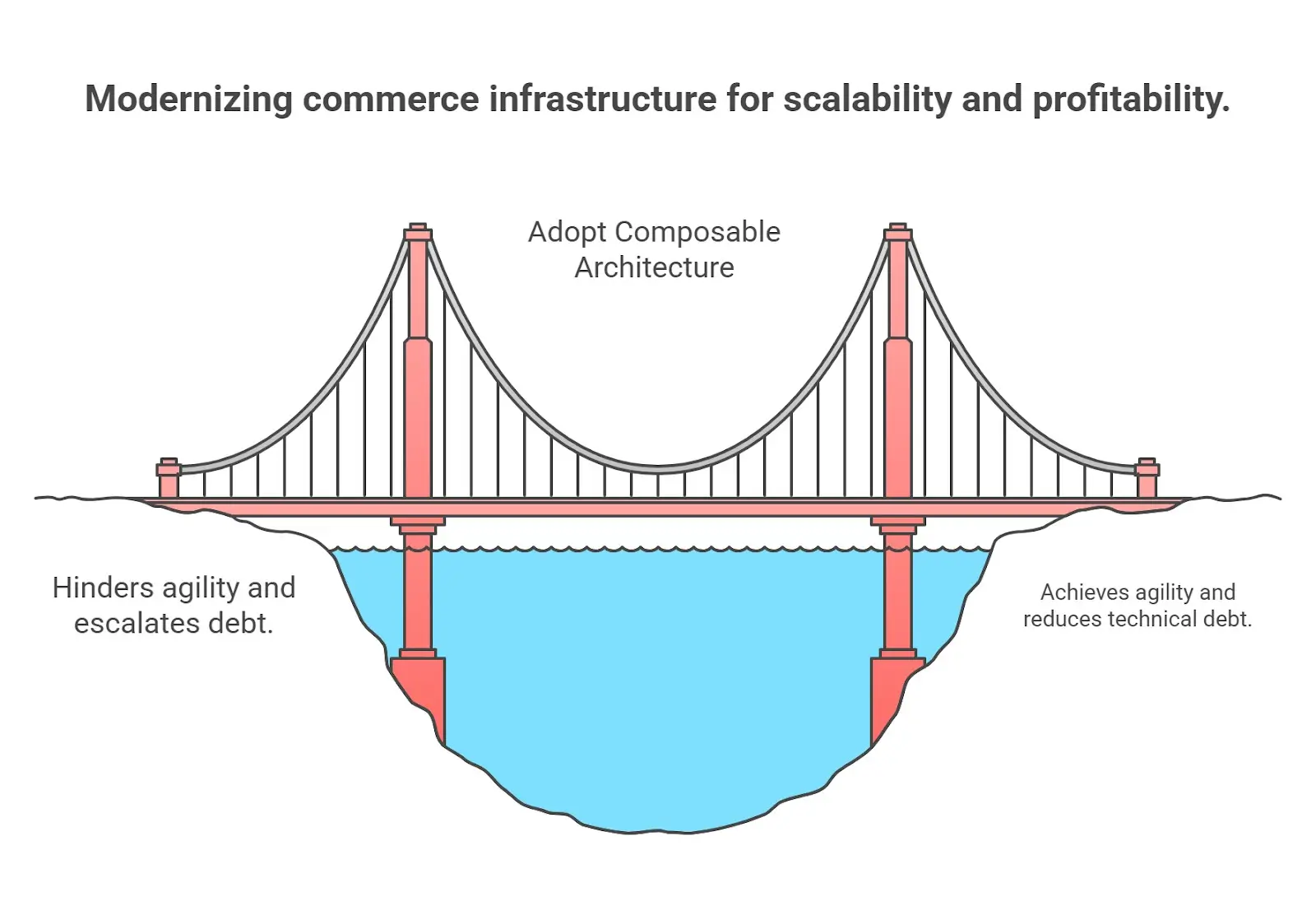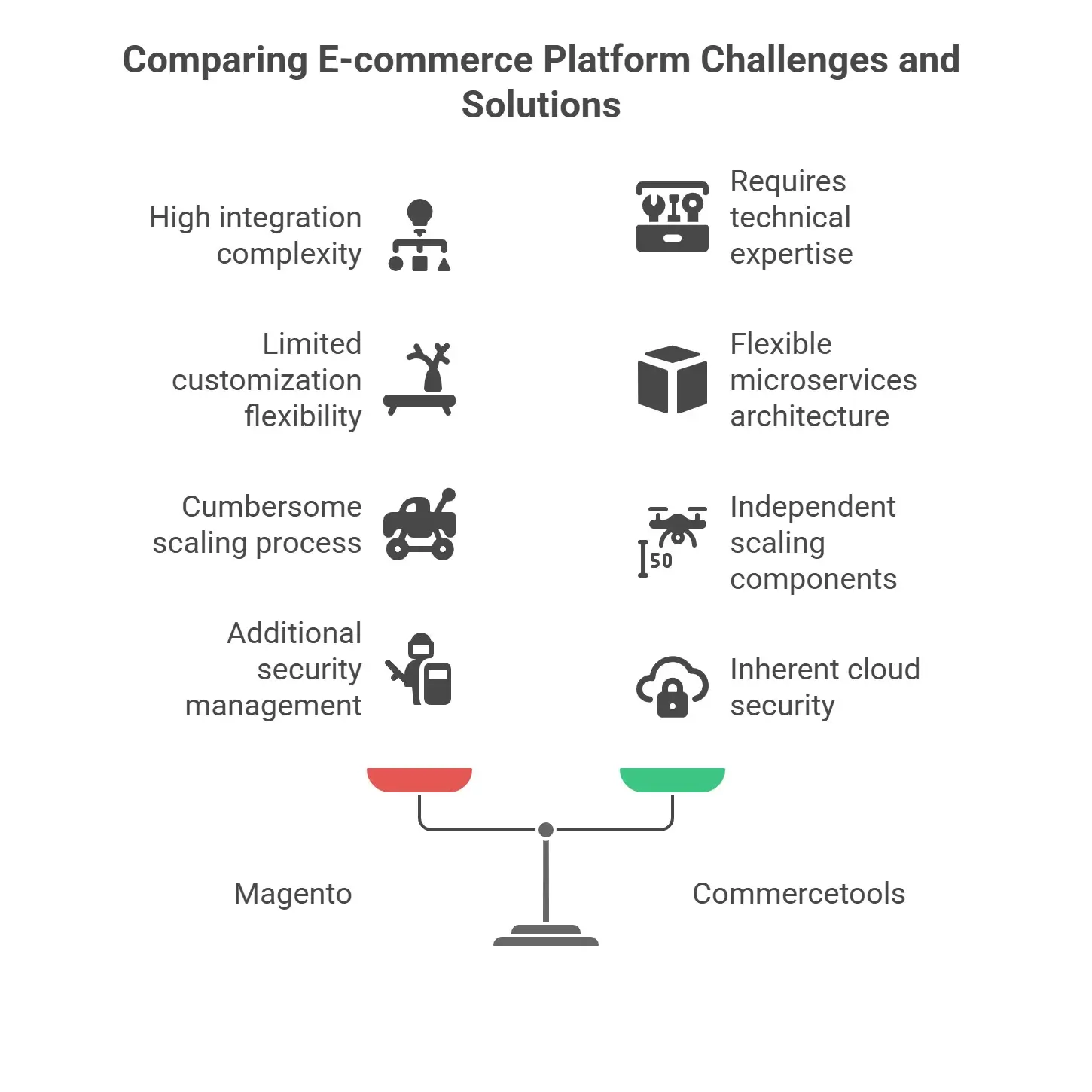The global e-commerce landscape is undergoing a profound transformation, with projected growth from $9,078.2 million in 2025 to $16,506.9 million by 2030 at a CAGR of 12.7%.
For enterprise decision-makers, the urgency to modernize commerce infrastructure has never been greater, as traditional monolithic platforms increasingly hinder agility and escalate technical debt.
This analysis provides a critical evaluation of two leading platforms—Commercetools vs Magento (now Adobe Commerce)—through the lens of enterprise-grade requirements for 2025 and beyond.
We’ll uncover which architectural approach, all-in-one or composable, aligns best with the strategic imperatives of scalability, adaptability, and profitability that define success in today’s dynamic digital economy.

What’s Driving the Platform Decision Urgency in 2025?
The past 2-3 years have fundamentally reshaped the e-commerce market, moving from a transactional focus to an experience-driven paradigm.
Global e-commerce revenue grew by 14.3% in November 2023 compared to November 2022, with the worldwide market expected to total $4.8 trillion in 2025 and reach $9 trillion by 2032 for B2C, and $36 trillion by 2026 for B2B.
This accelerated shift underscores the criticality of agile, robust platforms.
Strategic Imperatives Driving Platform Modernization
Modern commerce demands go far beyond basic online selling capabilities. Today’s successful enterprises must navigate five critical imperatives:
- Omnichannel Demand: Consumers expect seamless experiences across all touchpoints, necessitating platforms that unify sales, fulfillment, and engagement.
- Speed to Market: The ability to rapidly deploy new features and customer experiences is paramount for gaining market advantage.
- Personalization at Scale: AI and ML enable dynamic product recommendations, personalized marketing, and real-time customer support to enhance engagement and conversion rates.
- Operational Efficiency: Enterprises focus on optimizing online sales for profitability, demanding streamlined backend processes and reduced operational complexity.
- Supply Chain Resilience: Recent disruptions necessitate platforms that integrate with advanced supply chain management, offering visibility and adaptability.
Stakeholder Impact Analysis
Customers demand intuitive navigation, fast loading speeds, seamless checkout, and diverse payment options, including BNPL, to reduce cart abandonment. The global conversion rate sits at just 1.88% as of January 2024, highlighting customer sensitivity to platform performance.
IT Teams require flexible, API-first architectures that enable rapid development and integration with existing enterprise systems, minimizing technical debt.
Business Users need better control over products, promotions, shipping, and online experiences, with tools that empower data-driven decisions without extensive coding.
Quantifiable Success Metrics
The financial stakes of platform selection are substantial. 89% of retailers foresee revenue increases of 1% to 9% for 2024, driven by adapting to consumer behavior shifts. However, success requires measuring the right metrics:
- Conversion Rate Optimization: Even small improvements, like the 0.14% global conversion rate increase in January 2024, indicate significant revenue impact when multiplied across enterprise traffic volumes.
- Time to Market: Faster deployment of new features and experiences directly translates to competitive advantage and revenue capture.
- Cost Reduction: Optimizing infrastructure, logistics, and digital transformation investments can significantly improve operating margins.

How Do Integration Challenges with commercetools vs Magento Impact Your Platform Choice?
Enterprise e-commerce operations are increasingly burdened by complex, interconnected challenges that traditional platforms struggle to resolve, leading to significant business impact and missed opportunities.
Integration Complexity and Data Fragmentation
Many enterprises operate with fragmented customer journeys and inefficient inventory management due to disparate systems.
Integrating an e-commerce platform with existing ERP, CRM, payment gateways, and logistics providers can be monumental.
Magento’s Integration Reality:
While offering extensive features and a robust marketplace, Magento can incur escalating costs and complexity as businesses grow and demand bespoke customizations.
Custom code frequently becomes tightly intertwined, creating a brittle environment.
Commercetools’ API-First Approach:
Built on MACH principles (Microservices, API-first, Cloud-native, Headless), Commercetools champions flexibility but necessitates considerable technical expertise for effective integration.
However, a lack of prebuilt connectors for some commerce ecosystem applications remains a challenge.
Failure to achieve seamless integration leads to data silos, manual reconciliation, operational inefficiencies, and an inability to provide a unified customer view, directly impacting customer satisfaction and retention.
Legacy Constraints and Agility Limitations
Older, less flexible commerce technologies limit companies’ ability to innovate and respond swiftly to market changes.
Magento’s monolithic nature means customization can be challenging and costly, potentially limiting businesses as they grow and require more sophisticated solutions.
The core architecture of traditional platforms wasn’t designed for modern headless or composable paradigms.
Changes require deep modifications within the core system, which is time-consuming and prone to regression.
In a market where speed to market provides a unique advantage, legacy systems result in competitive disadvantage and lost revenue opportunities.
Scalability Limitations & Performance Bottlenecks
As digital commerce expands rapidly, platforms must effortlessly handle peak volumes.
Magento’s tightly integrated components can make scaling more cumbersome, potentially limiting businesses expecting rapid growth or unpredictable traffic.
Conversely, Commercetools’ microservices architecture allows for independent scaling of each component.
Performance bottlenecks lead to slow page loading speeds, poor user experience, increased bounce rates, and direct revenue loss.
During peak sales periods, system crashes or slowdowns can result in catastrophic financial and reputational damage.
Cybersecurity Threats & Compliance Burden
The increasing reliance on digital platforms has significantly heightened the vulnerability of business data and infrastructure to cyber threats.
For Magento, security requires additional management to ensure everything is up-to-date, whereas Commercetools, being cloud-native, brings inherent security advantages.
Data breaches lead to severe financial penalties, reputational damage, customer distrust, and potential legal action.
A comprehensive security posture requires continuous monitoring, proactive vulnerability management, and a platform designed with security and compliance embedded at its core.

What Are the Strategic Solutions for Modern Commerce?
Addressing these challenges requires a strategic pivot toward modern e-commerce architectures, underpinned by specific technological investments, process optimization, and organizational enablement.
The choice between Commercetools vs Magento represents a fundamental decision in this strategic shift.
Embracing Composable Commerce for Unmatched Flexibility
What are Commercetools?
Commercetools represents the composable commerce approach, allowing businesses to select “best-of-breed” components (payment, search, customer experience) and assemble a customized, future-proof platform.
As a founding member of the MACH Alliance, Commercetools embodies microservices, API-first, cloud-native, and headless principles.
Implementation Roadmap for Commercetools:
| Phase | Timeline | Complexity | Key Activities |
| Discovery & Blueprint | 3-6 months | High | Architectural audit, requirements definition |
| Pilot & Core Integration | 6-12 months | High | Core e-commerce APIs, payment integrations |
| Expansion & Optimization | 12+ months | Moderate-High | Legacy system replacement, best-in-class integrations |
Resource Requirements:
Significant upfront investment in specialized technical talent familiar with modern technologies, microservices, and API integrations.
Higher initial development costs compared to pre-built platforms.
Commercetools Integrations Advantage:
The platform’s API-first design enables seamless connections with existing enterprise systems, from ERP to CRM, without the architectural constraints of monolithic platforms.
Using All-in-One Power for Streamlined Operations
For businesses prioritizing rapid deployment and unified management with fewer technical resources, an all-in-one platform like Magento (Adobe Commerce) can be a strong choice.
It provides a comprehensive package with integrated features like catalog management, payment processing, and marketing tools.
Implementation Roadmap for Magento:
- Platform Selection & Core Setup (3-9 months): Leverage Magento’s ready-made package for quick launch. Configure out-of-the-box functionalities, including product catalog and basic payment integration.
- Customization & Extension (6-12 months): Utilize Magento’s robust community and marketplace for extensions to meet specific business needs. This may involve customizing themes and integrating necessary third-party modules.
- Optimization & Scaling (12+ months): Continuously optimize site performance, manage updates, and ensure security compliance.
Resource Requirements:
Access to commercetools vs Magento expertise is readily available through an extensive developer community. Initial setup costs may be lower, but maintenance and scaling expenses can escalate with growth.
AI/ML Integration for Hyper-Personalization
Regardless of platform choice, integrating AI and ML delivers hyper-personalized shopping experiences and optimizes internal operations.
Generative AI is rapidly transforming e-commerce by enabling dynamic product descriptions, personalized marketing, and tailored recommendations, improving conversion rates.
41% of retailers aim to improve workforce management using AI in 2024.
AI Implementation Strategy:
- Data Foundation (3-6 months): Ensure clean, consolidated customer and product data, crucial for practical AI algorithms. This involves unifying data from fragmented systems.
- Pilot AI Applications (6-12 months): Implement AI-powered product recommendations, deploy AI-driven chatbots for 24/7 customer support, and use AI for dynamic pricing optimization.
- Advanced AI & Automation (12+ months): Extend AI to inventory forecasting, fraud detection, and workforce scheduling. Leverage Generative AI for marketing content generation.
Success Indicators:
Increased conversion rates from recommendations, improved customer satisfaction scores from chatbots, optimized inventory levels, reduced fraud, and enhanced end-to-end supply chain visibility (expected by 46% of retail respondents using AI).
Supply Chain and Fulfillment Modernization
Reconfigure supply chains for greater resilience, regionalization, and efficiency to mitigate geopolitical tensions, fluctuating demand, and cost pressures.
97% of companies globally reconfigured their supply chains in 2023.
Current market conditions demand attention: average global lead time for production materials was 79 days in April 2024, and shipping from China to the East Coast US saw a 193% rate increase since October 2023.
Retailers expect two-thirds of deliveries to be fulfilled same/next day by 2029.
Supply Chain Modernization Phases:
- Assessment & Network Redesign (3-6 months): Evaluate current vulnerabilities, explore diversifying supplier bases, and adopt friend-shoring strategies.
- Logistics Technology Adoption (6-18 months): Invest in automated and micro-fulfillment centers, integrate predictive logistics and agile inventory management systems.
- Continuous Optimization (Ongoing): Implement real-time analytics for supply chain visibility and foster agile inventory management.
How Do You Navigate the Implementation Decision?
The selection and deployment of a new e-commerce platform demands a nuanced understanding of trade-offs and strategic priorities.
The “winner” in 2025 isn’t a universal declaration, but rather the platform that best aligns with an organization’s unique growth trajectory and internal capabilities.
Quick Wins vs. Strategic Priorities
Quick Wins with Magento:
For organizations needing to rapidly launch or migrate from an outdated system with clear, predefined functionalities, Magento’s out-of-the-box features offer quicker implementation and immediate time-to-market benefits.
Strategic Priorities with Commercetools:
Enterprises envisioning continuous innovation, complex integrations, and the need to future-proof their digital commerce should prioritize a composable approach.
This investment lays a foundation for sustained, adaptable growth, even if initial costs and technical complexity are higher.
Common Enterprise Pitfalls to Avoid
- Underestimating Technical Debt: Failing to account for long-term costs and limitations of extending monolithic architectures can lead to escalating maintenance expenses.
- Ignoring Internal Capabilities: Choosing a highly complex platform without strong internal IT teams can lead to implementation delays and project failure.
- Lack of Clear KPIs: Without defined success metrics beyond launch, it’s difficult to measure ROI and optimize platform performance.
Success Factors and Decision Framework
Technical Due Diligence:
Evaluate architectural flexibility, API robustness, and cloud-native capabilities.
Commercetools’ API-first approach offers distinct advantages for organizations prioritizing integration flexibility.
Total Cost of Ownership (TCO) Analysis:
Assess development, integration, maintenance, and scaling costs over 3-5 years.
Magento’s costs can escalate with customization, while Commercetools has higher upfront integration costs but potentially lower long-term scaling expenses.
Developer Experience: Consider ease of onboarding and community availability. Magento has an extensive ecosystem, while Commercetools favors modern tech-savvy developers familiar with API-first architectures.
Build vs. Buy Considerations
“Build” Approach (Commercetools):
Provides maximum flexibility and customization, allowing businesses to pick the best tools for their specific needs and avoid vendor lock-in. This path demands significant technical investment and ongoing internal expertise.
“Buy” Approach (Magento):
Offers a comprehensive, pre-integrated solution that simplifies initial setup and management, particularly for businesses with fewer technical resources. However, customization can become complex and costly within the platform framework.
Platform Comparison Summary
| Factor | Commercetools | Magento/Adobe Commerce |
| Architecture | Microservices, API-first | Monolithic, integrated |
| Implementation | 6-18 months | 3-9 months |
| Scalability | Independent component scaling | Platform-wide scaling |
| Customization | Unlimited through APIs | Extensive but constrained |
| Technical Expertise | High | Moderate |
| Best For | Rapid growth, complex integrations | Quick deployment, established businesses |
What Does This Mean for Your 2025 Strategy?
The commercetools vs Magento decision ultimately hinges on whether your enterprise prioritizes an integrated, faster-to-implement solution or a modular, highly flexible, and scalable architecture designed for continuous innovation.
For Rapid Market Entry:
If your primary goal is launching quickly with proven functionality, Magento’s comprehensive out-of-the-box features and extensive marketplace provide a clear path forward.
This approach works best for organizations with well-defined requirements and a limited appetite for technical complexity.
For Future-Proofing and Scale:
If your vision includes continuous innovation, complex third-party integrations, and the agility to rapidly adapt to market changes, Commercetools’ composable architecture provides the technical foundation for sustained competitive advantage.
This investment pays dividends for organizations planning significant growth or operating in dynamic markets.
The Hybrid Reality:
Many enterprises are finding success with a “best of both worlds” approach, using Magento for immediate needs while planning migration pathways to composable architectures as internal capabilities mature.
This strategy balances immediate business requirements with long-term strategic positioning.
Key Action Items for Decision-Makers:
- Conduct a Technical Readiness Assessment: Evaluate your current IT capabilities, developer resources, and integration requirements to determine which platform aligns with your organizational strengths.
- Define Success Metrics Beyond Launch: Establish clear KPIs for operational efficiency gains and customer satisfaction improvements that extend beyond basic conversion tracking.
- Calculate True TCO: Factor in not just initial implementation costs, but 3-5 year expenses, including development, integration, maintenance, and scaling requirements.
- Plan for Change Management: Ensure cross-functional teams understand the platform implications and have the training needed for successful adoption.
The winning platform for 2025 isn’t determined by feature checklists or vendor marketing claims.
It’s the platform that enables your organization to deliver exceptional customer experiences while maintaining the operational agility to capitalize on emerging opportunities.
Choose the architecture that positions your business not just for today’s requirements, but for tomorrow’s possibilities.
Frequently Asked Questions
Q: What’s the Main Difference Between Commercetools vs Magento?
Commercetools uses a composable, API-first architecture allowing maximum customization and independent scaling, while Magento provides an all-in-one platform with integrated features for faster initial deployment.
Q: Which Platform Is Better for Rapid Growth?
Commercetools excels in rapid, unpredictable growth due to its microservices architecture that allows independent scaling of components.
Q: How Do Implementation Timelines Compare?
Magento typically launches in 3-9 months due to pre-built features, while Commercetools requires 6-18 months for full implementation but offers greater long-term flexibility.
Q: Which Requires More Technical Expertise?
Commercetools demands higher technical expertise in modern development practices, APIs, and microservices. Magento has broader developer availability.
Q: What About the Total Cost of Ownership?
Magento has lower initial costs, but expenses can escalate with customization—commercetools has a higher upfront investment but potentially lower long-term scaling costs.
Q: Which Is Better for AI and Personalization?
Both support AI integration, but Commercetools’ flexible architecture makes it easier to integrate best-of-breed AI tools, while Magento offers more built-in AI features through Adobe’s ecosystem.
Read more: Guide to Add Related Products in Magento 2
Source: https://ecommerce.folio3.com/blog/commercetools-vs-magento/






